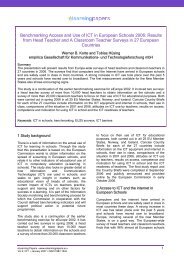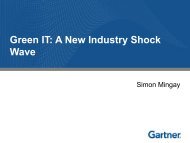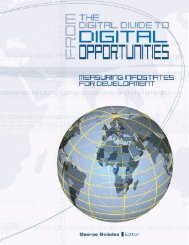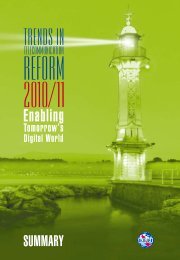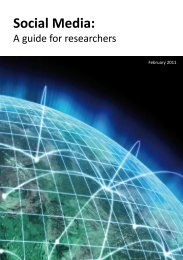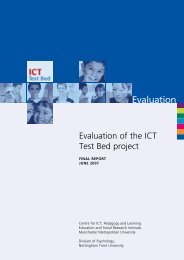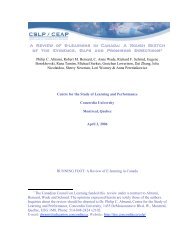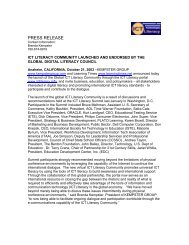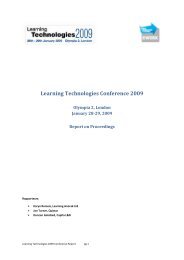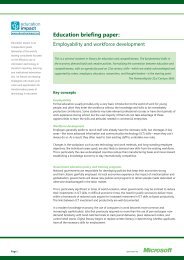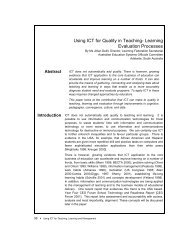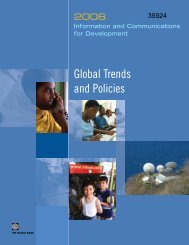The Digital Opportunity Index (DOI) - ITU
The Digital Opportunity Index (DOI) - ITU
The Digital Opportunity Index (DOI) - ITU
Create successful ePaper yourself
Turn your PDF publications into a flip-book with our unique Google optimized e-Paper software.
ture and growing use of advanced technologies,<br />
but only at levels around a third of those achieved<br />
by high-<strong>DOI</strong> economies. <strong>The</strong>y are also growing<br />
very fast - Brazil is now the tenth-largest Internet<br />
market in the world, while India appears in the top<br />
fifteen largest Internet markets for the first time.<br />
One interesting observation among the medium-<br />
<strong>DOI</strong> group is that there are a growing number<br />
of countries where Utilization scores exceed<br />
Infrastructure. Last year, Utilization exceeded<br />
Infrastructure scores in only six economies. 9 This<br />
year, Utilization exceeds Infrastructure scores<br />
in nineteen economies, thirteen of which are<br />
medium-<strong>DOI</strong> economies. <strong>The</strong> strong growth in<br />
broadband worldwide means that some economies<br />
are successfully leveraging their investments<br />
in infrastructure to yield more rounded growth<br />
and more advanced forms of usage across a broad<br />
Information Society. For example, in Morocco,<br />
broadband now accounts for 98 per cent of all<br />
Internet connections in 2006 due to an aggressive<br />
marketing campaign between operators fighting<br />
for market share, resulting in high utilization<br />
more than twice its infrastructure index (Box 3.2).<br />
This may represent a new form of technological<br />
‘leapfrogging’, where operators investing in<br />
Internet infrastructure are able to adopt the latest<br />
technologies.<br />
3.3.3 Economies with Low <strong>DOI</strong> scores<br />
(0.30 and less) – Mainly mobile<br />
<strong>Digital</strong> opportunity in low-<strong>DOI</strong> economies is still<br />
expressed in terms of potential access to the<br />
Information Society that has not yet been fully<br />
realized. Low-<strong>DOI</strong> economies include many lowerincome<br />
African and Asia-Pacific countries, with<br />
low levels of infrastructure, limited availability of<br />
the Internet and broadband and high prices as a<br />
proportion of local incomes. An hour’s Internet<br />
access per day exceeds the average daily income<br />
in most of these countries. In order for these countries<br />
to fully participate in the Information Society,<br />
prices must be reduced so that telecommunication<br />
services become more affordable.<br />
Box 3.1: Senegal – Reaping the Rewards of Early Reforms<br />
Senegal has succeeded in raising its <strong>DOI</strong> score from 0.22 in 2004 to 0.37 in 2006, whilst its ranking has risen 22<br />
places to 106th in 2006. This makes it the third-fastest rising economy worldwide in terms of increase in ranks<br />
(Table 3.3) and second-fastest in Africa. It is interesting to examine how Senegal has achieved this.<br />
<strong>The</strong> Government undertook early reforms in important areas. <strong>The</strong> incumbent operator, SONATEL, was partly<br />
privatized in 1997, the first African telecommunication operator to be listed on a stock exchange. In 2001, Senegal<br />
established the Telecommunications and Posts Regulatory Agency (ARTP). In 2004, the Ministry of Posts,<br />
Telecommunications and New Information Technologies was created. <strong>The</strong> Government aims to make ICTs a<br />
driver of economic growth and modernization. <strong>The</strong> Government issued a sector note on telecommunications<br />
in January 2005 which calls for an increase in telephone subscribers to 3 million by 2008. This target is likely<br />
to be achieved, with 2.5 million telephone subscribers by June 2006 already.<br />
Senegal was also connected to two submarine fiber optic cables, dramatically increasing its international connectivity.<br />
SONATEL doubled traffic bandwidth on Internet services in less than 2 years surpassing in September<br />
2006 the mark of 1.24 Gbit/s, according to SONATEL. By 2006, Senegal had 775 Mbit/s of international<br />
Internet bandwidth, one of the highest per capita capacities in Africa. Senegal hopes to leverage its abundant<br />
bandwidth by serving as a hub for western Africa. SONATEL has launched ADSL and, by the end of 2005, some<br />
89 per cent of all Internet connections were already broadband, suggesting a successful “technological leapfrogging”<br />
strategy.<br />
Despite these impressive accomplishments, Senegal needs to go further if it is to be successful at using ICTs<br />
for development. Although the growth of broadband subscribers has averaged 2’000 per cent over the last<br />
five years, Internet subscriber penetration is just 2.3 per 100 inhabitants, due to widespread use of community<br />
multimedia telecentres (Box 6.3 in Chapter six). <strong>The</strong> growth in Internet traffic reflects the boom in the number<br />
of users in Senegal in recent years. As broadband prices fall, more people are using the Internet, both at work<br />
and home. Standard broadband subscriptions cost EUR80 for installation and EUR40 per month for the service,<br />
although cheaper deals are becoming available. <strong>The</strong> real key to growth in Internet use has been the surge in<br />
popularity of cybercafés, which offer a high speed Internet line for as little as EUR0.45 per hour (Box 6.3).<br />
Source: UNCTAD, adapted from Agence de Régulation de Télécommunications (ART, Sénégal), “Le marche de<br />
l’Internet”, web page, at: www.artp-senegal.org/telecharger/Fiche_Internet_2005.pdf<br />
World Information Society Report 2007<br />
43



